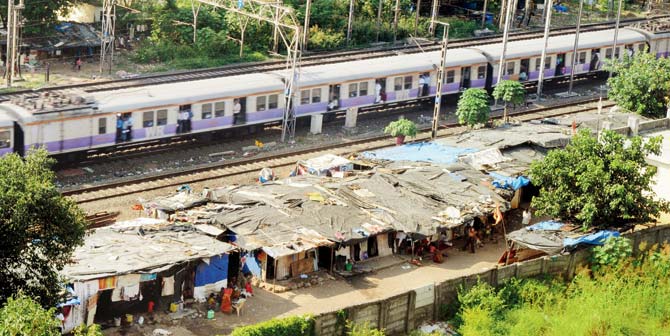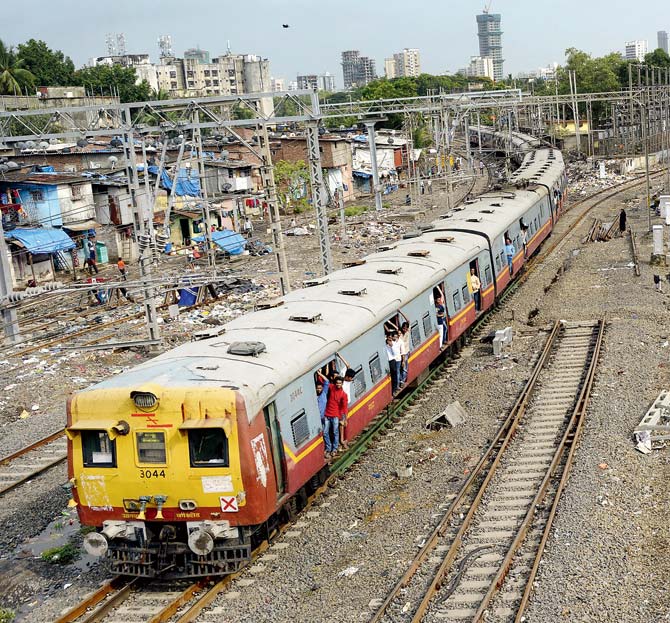The decision to demolish illegal structures along Mumbai Central-Virar belt, follows a high-level meeting between MMRDA and Indian Railways. Clearing of encroachments will begin soon after monsoon


Squatters have taken over the land running parallel to the tracks between Malad and Kandivli
ADVERTISEMENT
After years of seeing its plans thrown off track by encroachments, WR has decided it has had enough. It will now start demolishing these illegal structures so that it can complete its pending projects, starting with the R918-crore sixth line between Borivli and Mumbai Central, which has been stuck for nearly a decade.

Western Railway is plagued by illegal encroachments all along the Mumbai Central-Virar belt, but will slowly tackle this menace. File pic
The sixth line was given the green signal in 2008-09, but WR has not been able to start work on it so far due to encroachment. But it looks like the dice are finally rolling, as the authorities have now decided that once the monsoon ends, they will demolish all 607 illegal structures that stand in the way.
This decision was made during a high-level meeting on September 7, when Indian Railways discussed the slow progress on the much-needed railway line that will cater to long-distance trains.
Heavy loss
WR has already suffered heavy losses on the fifth line because of land disputes. The fifth line was also meant for long-distance trains, and had been built in two sections — Borivli-Santacruz and Mahim-Mumbai Central. The two sections were supposed to merge between Santacruz and Mahim. WR had almost finished the work when people expressed objections, stating that the rail line would obstruct their shortcut to the mosque near Bandra Terminus.
Also read: CR begins razing structures around Parsik tunnel
Since slum dwellers make up a significant vote bank, even politician were unwilling to get involved. Even though just 10-20 metres of the track were left to be built, WR was forced to change the alignment at the additional cost of Rs 10 crore.
Railway officials seem to have learnt from this experience, however, and are now keen to remove any such obstacles from the sixth line. “We have informed the state government about removing these illegal structures. Separate lines for long-distance trains will help us with suburban train operations as well,” said G Agrawal, general manager, WR. Railway officials claim that it will take at least 6-7 years for them to complete this line, which shall be laid in two phases. Until now they have already spent Rs 140 crore on basic technical works.
As Line 6 is part of the Mumbai Urban Transport Project (MUTP) phase-2, the demolition of encroachments and rehabilitation of slum dwellers will be undertaken by the Mumbai Metropolitan Region Development Authority (MMRDA). “We will be demolishing these 607 illegal structures post monsoon,” confirmed Metropolitan Commissioner UPS Madan.
Tip of the iceberg
It is not just the long distance line that is plagued by this issue. In fact, the hutments on this line count for just 9% of the total encroachment along the Mumbai Central-Virar belt. There are over 6,500 illegal structures occupying a whopping 6,51,500 square feet on the western line.
The problem is by far the worst at Bandra East, where a clump of over 2,700 illegal structures occupy a large part of Garib Nagar. Many of these structures have climbed as high as four storeys.
This is followed by Virar, where there are more than 1,000 encroachments. Wadala witnesses the least encroachment on railway property, with just two encroachers occupying 200 sq ft plots.
Railway officials claim that such illegal encroachments are difficult to control, especially since local politicians refuse to help at the risk of losing their vote bank.
Officials added that it should also be the responsibility of the state government to look into the removal or rehabilitation of the encroachers. However, WR will now slowly tackle the encroachment menace in these areas as well.
 Subscribe today by clicking the link and stay updated with the latest news!" Click here!
Subscribe today by clicking the link and stay updated with the latest news!" Click here!






